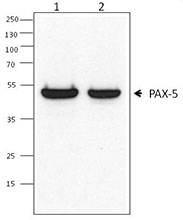PAX5 Rat Monoclonal Antibody [Clone ID: 1H9]
Other products for "PAX5"
Specifications
| Product Data | |
| Clone Name | 1H9 |
| Applications | WB |
| Recommended Dilution | WB |
| Reactivities | Human, Mouse |
| Host | Rat |
| Isotype | IgG2a, kappa |
| Clonality | Monoclonal |
| Immunogen | Recombinant mouse Pax-5 protein |
| Formulation | This antibody is provided in phosphate-buffered solution, pH 7.2, 0.09% NaN3. |
| Concentration | lot specific |
| Purification | The antibody was purified by affinity chromatography. |
| Conjugation | Unconjugated |
| Storage | Store at -20°C as received. |
| Stability | Stable for 12 months from date of receipt. |
| Predicted Protein Size | 42 kD |
| Gene Name | paired box 5 |
| Database Link | |
| Background | Pax5, also known as BSAP (B cell specific activator protein), is a member of the paired box (Pax) family of transcription factors. PAX proteins are important regulators in early development, and alterations in the expression of their genes are thought to contribute to neoplastic transformation. Pax5 is the only member of the Pax family of transcription factors that is expressed in hematopoietic cells. During embryogenesis, Pax5 is transiently expressed in the brain of mice and in the mesencephalon and spinal cord of humans. Its expression is upregulated early in B cell development at the time of B cell commitment and is maintained throughout most subsequent stages. Suppression of Pax5 is essential for expression of Blimp-1 and the terminal differentiation of plasma cells. In the spleen, expression of Pax5 is higher in marginal zone B cells (B220+ CD21high CD23low) than in other B cells, especially the transition 1 stage (B220+ CD21- CD23-). In addition to its role in B cell development, Pax5 also affects VH-DJH heavy chain recombination as well as influencing the expression of many other B and non-B cell related proteins. Its expression has also been detected in developing CNS and testis and so the encoded protein may also play a role in neural development and spermatogenesis. This gene is located at 9p13, which is involved in t(9;14)(p13;q32) translocations recurring in small lymphocytic lymphomas of the plasmacytoid subtype, and in derived large-cell lymphomas. This translocation brings the potent E-mu enhancer of the IgH gene into close proximity of the PAX5 promoter, suggesting that the deregulation of transcription of this gene contributes to the pathogenesis of these lymphomas. Alternatively spliced transcript variants encoding different isoforms have been described but their biological validity has not been determined. |
| Synonyms | ALL3; BSAP |
| Reference Data | |
| Protein Families | Transcription Factors |
Documents
| Product Manuals |
| FAQs |
{0} Product Review(s)
0 Product Review(s)
Submit review
Be the first one to submit a review
Product Citations
*Delivery time may vary from web posted schedule. Occasional delays may occur due to unforeseen
complexities in the preparation of your product. International customers may expect an additional 1-2 weeks
in shipping.






























































































































































































































































 Germany
Germany
 Japan
Japan
 United Kingdom
United Kingdom
 China
China



